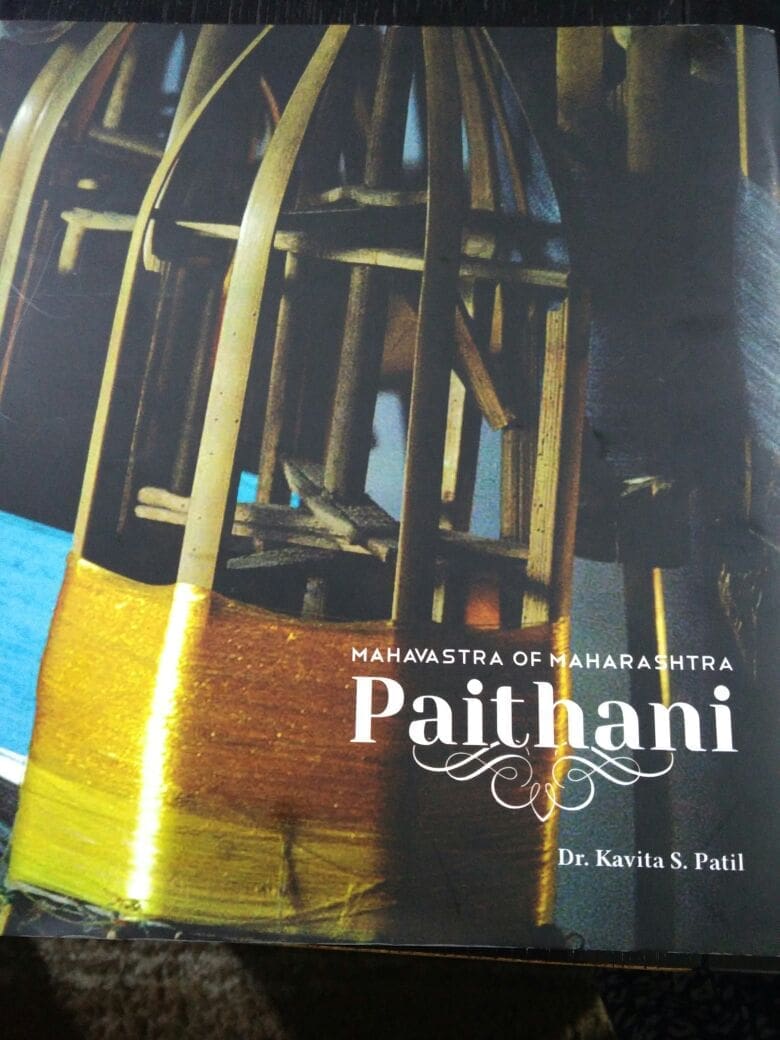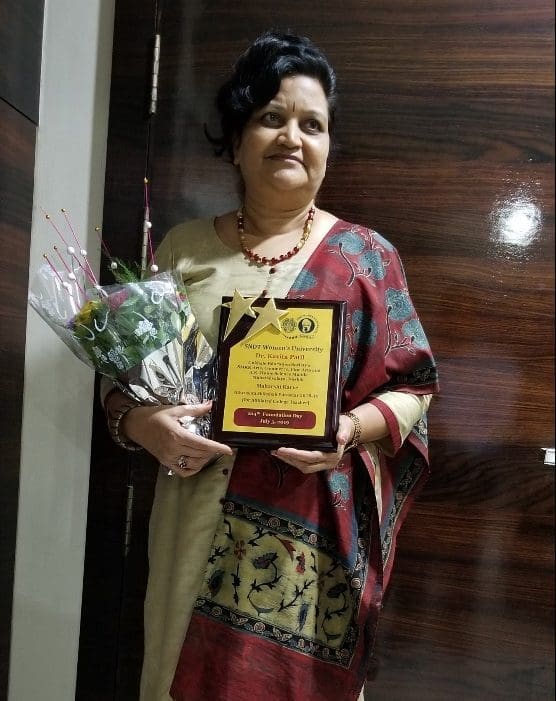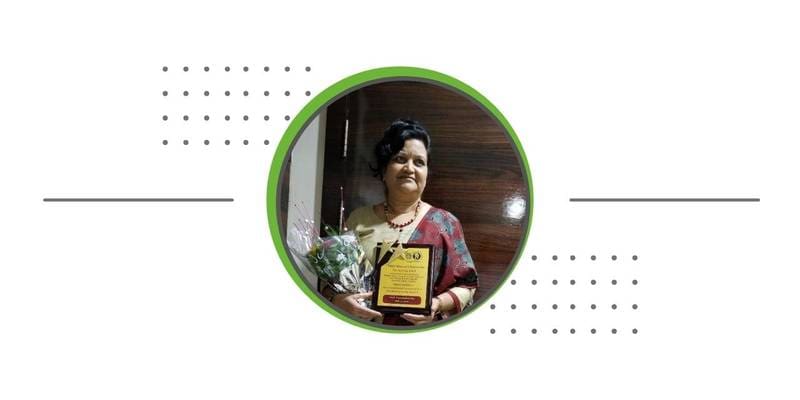WAEVING TOGETHER DECADES OF EXPERTISE
The teaching profession is one of the most noble professions. Teaching is a method of facilitating learning. It is the specialized application of information, abilities, and characteristics aimed to deliver one-of-a-kind service to fulfil the educational needs of the person and society.
Dr. Kavita Patil is one such dynamic personality who is not only a published author and textile specialist but has also been educating many lives with her knowledge for decades. She is endowed with a wealth of knowledge and skill in the field of textiles.
- Share your journey of Educational and Professional life. What difference do you see in the Textile Industry then and now?
I began with a scientific background, unsure of what my future held for me. I eventually ended up in the field of Home Science, with a specialization on Textiles and Clothing. Despite my interest in computer science, I moved to Mumbai and opted to pursue my M.Phil in Home Science at the SVT College of Home Science, which is affiliated to SNDT Women’s University and is directed by Dr. Padhye. Dr. Padhye later encouraged me to continue my textile study and get a Ph.D. in the field.
When I was initially exposed to Home Science, I knew I wanted to work in the textile business and eventually pursue a career in fashion design, but fate had different ideas for me. I was subsequently contacted by the Gokhale Education Society, who asked me to join their team as a Lecturer in their Textiles & Clothing Department at SMRK-BK-AK Mahila Mahavidyalaya in Nashik. Somehow, I found my passion in teaching and shaping the careers of the thousands of students I have had the absolute pleasure of guiding. While my journey as a teacher continued, I was introduced to the Paithani Sari on Educational visits with my students. Paithani Sari is a traditional Maharashtrian attire and is found in the heart of Yeola, a small town in Maharashtra. They say that a Woman’s first love must be 6 yards of Elegance which is also known as a Sari. And there it was, I fell in love with the Paithani Sari immediately and started having interactions with the weavers in Yeola, understanding the process and methods of creating this beautiful piece of cloth. Eventually, this paved my way to conducting research work on the Paithani Sari in Yeola and I finally received my Doctorate Degree in 2006.
Up to 1990, the consumers were more likely to wear clothes that are manufactured from comfortable as well as affordable textiles. But today the scenario has changed completely, the technology is advancing at astonishing speed changing the face of textile and fashion in the 21st century. Advancements in communication technology and internet facilities have revolutionized the industry, allowing customers to buy the clothing of their choice from around the world with a click of a mouse sitting comfortably at home. It has promoted a rapid response cycle from textile and fashion designers, who can design and produce in a short span of time. Textiles and Fashion are increasingly becoming influenced by digital technologies, which have increased efficiency of production compared to traditional techniques.
- Being a designer, you have an immense number of career opportunities to explore, why did you choose teaching as your profession?
Though I always wanted to make it big in the Textile Industry and eventually get into Fashion Designing, I was at the same time ready to grab any opportunity that knocked my way. Back in the day, I was the youngest daughter of the family, so far away from home in Mumbai and when I received an offer from the Gokhale Education Society as a Lecturer, my family wanted me to go for it. In those times being a teacher was considered as a White Collar job, not that any other job isn’t but it’s just how our thought processes are shaped. With a minimal experience of what life had in store for me, I went ahead and grabbed that opportunity. Today if you ask me, I think I wouldn’t have wanted it any other way. Teaching is now my passion, and I am grateful that I got this opportunity back when I graduated from college.
- Was it tough for you to choose this less explored career path in the time when Indian women were expected to peruse up to mark education and take care of a family? Who was your biggest support system?
I think back when I started fresh almost every career path was less explored for Indian Women. We belong to a society where women are by default expected to pursue only up to mark education and then take care of the family. But 1 amongst every 10 mothers of India does not feel that way. And fortunately, my mother has been my strongest pillar in pursuing my dreams. And though I have spent most of my life teaching, I believe I have a long way ahead of me and I would want to get into the Textile industry and Fashion Designing. It’s never too late!
- People learn a lot of things from their teachers, but as a teacher, what things have you learned throughout your career?
As you must have heard, “A Teacher is always a student”. Being a teacher, you must keep yourself updated with every little change that is happening in the world every day. It’s a learning process for a teacher too. My career in teaching not only gave me the satisfaction of shaping my student’s lives but also gave me immense knowledge of the field, confidence, positivity, sincerity and so much more. It encouraged me to do my research work, learn about new methods and technologies, explore different ideas, and creatively implement them in my teaching. One of the best feelings in the world is giving and I have had a first-hand experience in that through teaching. I will always be grateful to the almighty for giving me this career opportunity, it has not only given me immense satisfaction but has also kept me young at heart and enthusiastic like all my students.
- Your work in Paithani is not only inspiring but also making the Paithani sector proud for such big acknowledgments. Share your journey about getting your work published, what inspired you and what difficulties did you face?
 I started my research work at Yeola (Paithani Manufacturing Center) Dist: Nashik, which was an epic journey for about six years. Initially, I had to work very hard for overcoming difficulties in dyeing, designing, and weaving, faced by the Paithani weavers and dyers at Yeola. Though Paithani weaving is their ancestorial business, they were not capable of making any small change in Paithani design or structure. Monotony was a serious drawback at that time. I realized this during a survey of the weavers that I conducted at and around Yeola. Picking this thread, I decided to direct my work with an aim to weave a Paithani with innovative designs and modifications.
I started my research work at Yeola (Paithani Manufacturing Center) Dist: Nashik, which was an epic journey for about six years. Initially, I had to work very hard for overcoming difficulties in dyeing, designing, and weaving, faced by the Paithani weavers and dyers at Yeola. Though Paithani weaving is their ancestorial business, they were not capable of making any small change in Paithani design or structure. Monotony was a serious drawback at that time. I realized this during a survey of the weavers that I conducted at and around Yeola. Picking this thread, I decided to direct my work with an aim to weave a Paithani with innovative designs and modifications.
In the beginning phase of my work in Yeola, I would be teary-eyed, working with artisans, who had faith in their monotony, and they showed no faith in me and the work that I was hoping to carry out. I did not stop here and continued working hard, with courage in my heart I was determined to win the trust of all the weavers. I kept observing their work and conducting workshops making the weavers understand my motive. Slowly but steadily, I managed to win their trust in my work and then there was no looking back. As a team, we worked hard to make their lives better and to give the recognition that Paithani sari always deserved. I was successful in completing my Ph.D. after 6 years of immense hard work and dedication.
Getting acquainted with Jacquard and Dobby designing in Paithani set up, was a big challenge for me. With a lot of hustles, I acquired training in silk designing and dyeing at a weaver’s service center and continued my journey confidently. My entire work is dedicated to all the weavers and dyers of Yeola.
I am ecstatic that my research work is percolated in the community of artisans and not stalked only in the racks of the library.
- What future do you think Paithani has? Do you foresee prosperity and preservance, or do you think it will diminish with time? What steps should the industry take to preserve its traditional heritage?
Paithani, a gold embroidered gorgeous fabric, is a treasure & rich heritage of traditional textiles of India. The Peshawa had a special love for Paithani textiles. No Maharashtrian wedding trousseau was complete with the Paithani Sari & Shela or Stole, the best, the family could afford. These saris became treasured heirlooms that could be preserved & worn by three generations of women. This tradition is continued to date so no question of diminishing the textile.
Peshawa had a special love for Paithani textiles. No Maharashtrian wedding trousseau was complete with the Paithani Sari & Shela or Stole, the best, the family could afford. These saris became treasured heirlooms that could be preserved & worn by three generations of women. This tradition is continued to date so no question of diminishing the textile.
In the past, a design on saris used to run in the market for more than 5 years, but nowadays a customer’s demand for a variety of designs, make it mandatory to produce new designs. In designing, day-to-day competition is on increase & the weaver’s will have to struggle every time to create a new variety of saris with heart-touching designs to withstand in the market. I have done the work to some extent.
The fear is, at the stage of contemporizing, diversification of these traditional textiles, where the originality of traditional textiles is vanishing. Handloom Industry should focus on the revival of traditional weaving techniques & traditional designs which will help in preserving indigenous traditional heritage.
- Do you think Western Clothing is harming traditional Indian Textile heritage? What is your opinion about the major shift of textile & Fashion designers towards western clothing & styling?
I think traditional Indian Textile heritage is a valuable addition to western clothing. Upcycling of these traditional textiles is a new boom in this fashion era. Not only are western clothing styles extremely romantic, but they are also a staple in today’s fashion world. From the time of cowboy, western clothing has made an impression on the fashion industry, both for Men & Women. Western Clothing is in such high demand that they have Western stores dedicated to making this style available to everyone.
Youngsters today argue that we must learn to go with the flow & therefore taking up new trends is a better option. A handful of people still believe that our traditional clothes represent our culture & identity & to let go of them will be like discarding our own culture. However, I feel Western trends offer freedom of expression. One can add his or her own tastes & ideas to them & they are quite classy, stylish & attractive. I personally believe that designers should keep a balance in all things & hence, it is inappropriate for one to completely set aside their traditional clothes & become a follower of Western trend, or vice versa.
- What advice do you have for budding textile designers?
Textile designing is not everybody’s cup of tea, it’s meant for a creative streak in themselves. A textile designer must have a lot of patience & should be punctual. A designer should be cautious about the needs of his prospective clients. A successful designer needs to know all the techniques related to textile designing as well as he or she needs to be updated with the current trends. The designer should be able to think out of the box but at the same time, his/ her designs should have a practical element. It is a need of an hour to revive traditional indigenous fabrics of India & Contemporizing of any traditional textile should be maintaining the essence of the original one.
- What is your international footprint?
The journey of Paithani from India to various countries like Switzerland, Australia, and Dubai was splendid! Paithani innovative motifs developed during my research work were selected for display in “Textile Exhibit” of “World Congress” is a precious footprint for me.
Giving an identity to our traditional treasure worldwide has given me more satisfaction than receiving a patent for my work.
Lastly, I would like to say it has been commonly observed that traditional silk saris & garments find a superior place in an Indian Women’s wardrobe, because of its dignity, glamour & splendor so treasure this rich heritage of India.
Thank your editorial board for giving me an opportunity to share my views on Designing which is the heart of textiles.

